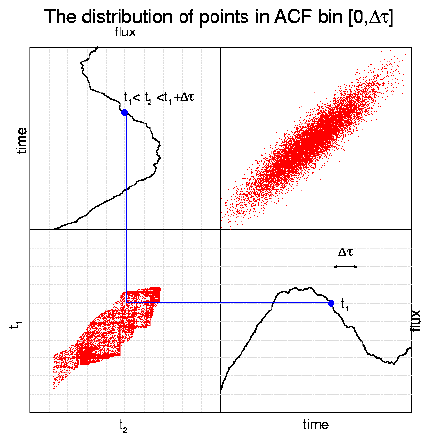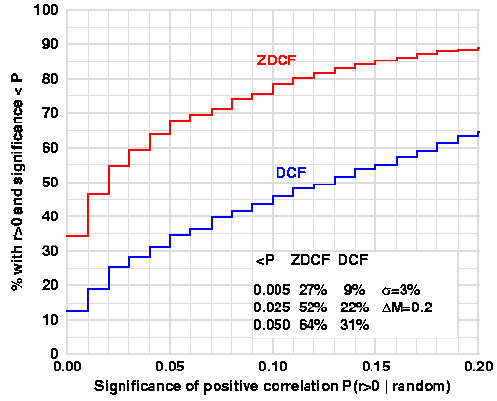| The z-transformed discrete correlation function (ZCDF) | |
| Astronomical time series are often too sparse and unevenly
sampled to be inverted for analysis in the frequency domain, and the analysis
is carried out in the time domain by the Cross-Correlation function
(CCF) and
Auto-Correlation function (ACF). There are two approaches
for dealing with the gaps in the data: interpolation and discrete binning.
Interpolation becomes unreliable when there is significant power on time
scales smaller than the typical gap size. The discrete correlation function
(DCF) method (Edeleson & Krolik 1988) avoids interpolation by binning
the time difference pairs and calculating the mean and variance of each
bin. The drawback of this method is that the DCF suffers from the same
problems as the closely related linear correlation coefficient
r,
which
measures the correlation between independently drawn pairs (x,y).
The
sample distribution of r is known to be very skewed and far from
normal.
Fisher's z-transform of r (Fisher 1920) is approximately normally distributed when (x,y) are drawn from a binormal distribution, and can therefore be used to estimate the confidence level of a measured correlation. Because the points in the light curve are not normally distributed and are auto-correlated, it is not immediately obvious that the z-transform is generally applicable for normalizing the DCF. However, it is possible to show that under a wide range of conditions the ZDCF does provide significantly improved estimates of the CCF. Furthermore, a new algorithm for setting the bin sizes removes biases due to the number of data points in the light curve. This is important when comparing the CCF of different light curves. More details about the ZDCF method and its advantages over the interpolation method and the untransformed DCF can be found in Alexander (1997). |
|

|
|

|
|
| A FORTRAN 77 implementation of the ZDCF algorithm
can be downloaded from here. The
instructions appear as comments at the head of the file. The ZDCF should
be cited as T. Alexander, 1997, in Astronomical Time Series, Eds. D.
Maoz, A. Sternberg, and E.M. Leibowitz, (Dordrecht: Kluwer), 163.
Questions, suggestions and bug reports are welcome (tal.alexander@weizmann.ac.il). I would also appreciate receiving a short note about projects (and papers) where the ZDCF was put to good use. |